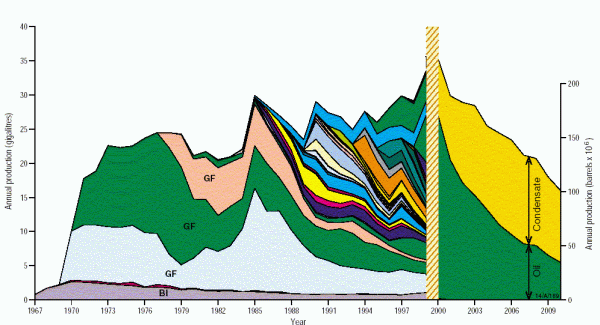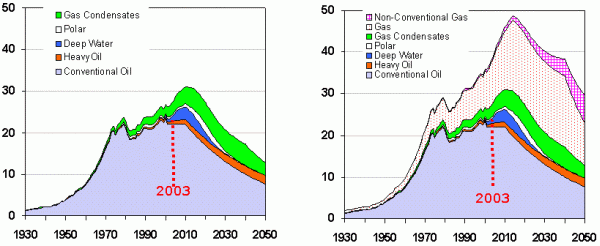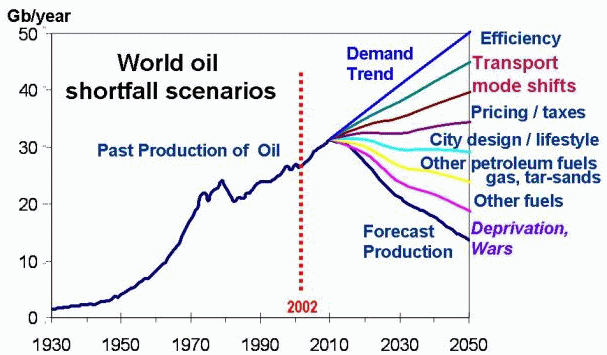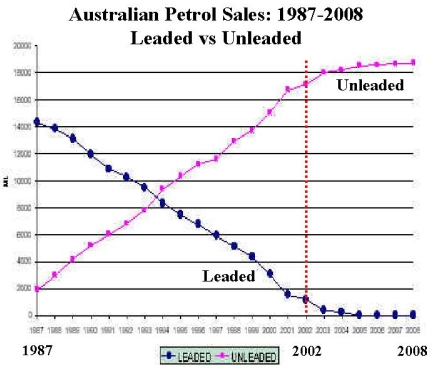
Peak Oil

PEAK OIL is a term used to describe the point
where demand for oil outstrips supply.
Source: ASPO Australia (Australian Association for the Study of Peak Oil & Gas
http://www.aspo-australia.org.au/
D7a_s1
|
OIL PRODUCTION DECLINE
This
is a modified version of a paper prepared privately for the
Australian Transport Research Forum in Adelaide, 29 September
2004. As a result, this review still shows vestiges of its
transport origins and hence focuses on demand-side rather than
supply-side countermeasures.
D7a_s2 |
Australian
oil production decline
Australia has been
shielded from past oil shocks by our domestic oil production from
Bass Strait. Hence, as a nation we have not learnt as much about oil
conservation and transport planning as European countries, especially
the Netherlands which radically changed its transport planning policy
to reduce its oil dependence after the 1973 oil crisis.
However,
Bass Strait production has been declining since 1985 and until now
other fields have filled the production gap. Reliable recent
predictions by Geoscience Australia and Woodside indicate that
Australia's oil and condensate production will fall substantially in
the next decade (Akehurst (2002), APPEA (2004)).
Figure
2. Oil and condensate production profiles of individual Australian
fields, and the forecast cumulative production at 50% probability
derived from industry data, Powell (2001), Akehurst (2002). BI
denotes Barrow Island; GF denotes giant Gippsland Basin Fields.
The
dominance of a few large fields, shown in Figure 2, is typical of oil
regions. The giant fields are normally found first. An increasing
discovery rate of usually progressively smaller fields is needed to
keep production relatively constant as the giant fields decline. Then
inability to keep finding adequate volumes in ever-smaller fields
leads to an overall decline.s becoming increasingly vulnerable to
serious oil shortages, in the short term (within a year), in the
medium term (within 5 years) and in the long term (within one or at
most two decades). Self-sufficiency is expected to decline from an
average of 80-90% over the past decade to about 20% by 2020 (APPEA
(2004))
D7a_s3
World
oil production decline predictions
A
world-renowned US Geological Survey petroleum geologist, Les Magoon,
visited Australia in November 2001 as the Distinguished Visiting
Lecturer of the Petroleum Exploration Society of Australia. He gave
talks around Australia entitled "Are We Running Out of Oil".
As reported (Australian Energy News (2001), Magoon (2001)), he
describes the "Big Rollover" as the change from the current
world oil buyers'-market to a world sellers'-market when global
production starts to decline. Various forecasts have put the "Big
Rollover" date at sometime around 2003, 2007, 2010 or by 2020
(Andrews and Udall (2003)). "At BP, our best estimate of when
global oil shortages will begin to bite deeply is between 20 and 40
years", Greg Bourne, Regional President of BP Australasia, told
the 5th Energy in WA conference in Perth in March 2003.

Figure
3a: Current forecast of future world oil production, including
non-conventional oil. (ASPO (2002)). Scale is in gigabarrels of
oil-equivalent per year. The peak of the curve is the “Big
Rollover” Figure 3b: Current forecast of
future world oil and gas production, (ASPO (2002)). The inclusion of
gas does not change the shape of the global hydrocarbon depletion
curve substantially.
Prof. Pierre-René
Bauquis of the French Institute of Petroleum told a combined meeting
of the Society of Petroleum Engineers and the Petroleum Exploration
Society of Australia in Perth that he expected global oil production
to start its terminal decline in about 16 years (Bauquis (2004)). He
does not see any significant renewable energy substitutes for
petroleum over the next 20-50 years. He was also dismissive of
hydrogen as a transport energy carrier and foresaw the use of nuclear
energy to help manufacture synthetic hydrocarbon fuels
As can
be seen in Figure 1, there are some considerably more optimistic
forecasts of future oil supplies. The most optimistic ones are driven
by economic and political perspectives, rather than by geology and
engineering constraints, for example see Lynch (2002). There are very
considerable grounds on which to doubt the forecasts published by the
International Energy Agency. The IEA takes without question the oil
reserve data provided by all the national governments. Many of these
estimates are clearly misleading as they either increase dramatically
without any matching exploration success, or they remain constant for
years in spite of substantial production which must reduce the actual
oil reserves. Conflicting definitions and national and political
priorities make the IEA figures as dubious, for example, as similar
audited and glowing accounts of the financial strength of HIH and
Enron just before their catastrophic corporate crashes.
D7a_s4
Shell
has recently revised its "proven reserves" downward by 23%,
showing that oil-company reserve claims are subject to uncertainties
and mistakes. The scope for analogous errors and
misrepresentation at the national level is very substantial. Mexico
has twice halved its claimed reserves since the mid 1990s. Recent
presentations by Matthew Simmons (Simmons (2004), (2004a)) cast
considerable doubt on the reliability of the claimed Saudi oil
reserve figures. Similar doubts about OPEC's overall reserves are
also raised by Salameh (2004)
In the case of Saudi Arabia, any
substantial errors in reported reserve estimates are of very serious
global significance. There is of course the complementary but lower
probability that some reserves may have been understated, but most
concern has been expressed about over-optimism.
Preparation for Probable Oil Shocks
There is a great deal that can be done to prepare for the likelihood of future oil shocks and hence to ameliorate the effects when (or if) they hit us. Many possible precautions will be "no-regrets" options already justified on equity, environment, health, social or economic grounds. Australia's existing reserves of uncommitted natural gas coupled with local understanding of demand management (especially in water use efficiency and TravelSmart individualised marketing) provide an encouraging opportunity for the nation to both forecast and to weather the coming storms better than many other regions. It is particularly important that the issues be tackled seriously and urgently at all levels in the community. WA Planning and Infrastructure Minister, Alannah MacTiernan (2004) said, in opening the "Oil: Living with Less" conference "It is also certain that the cost of preparing too early is nowhere near the cost of not being ready on time."

Figure 5. An adaptation of the scenario outlined by Swenson (1998) of the various mechanisms of bridging the coming gulf between growing current world demand for oil and the forecast decline in the production of conventional oil (Robinson (2002)).
D7a_s5
Communication
about potential solutions and their limitations
It
will be crucially important that there be open and informed
discussion about oil depletion. Broad consideration of the various
strategies for reducing our oil vulnerability; especially their
limitations and the input energy needed, the time required and the
costs needed to implement them are essential precursors to effective
decision-making.
Contrary to many common predictions, it is
highly unlikely there will ever be a single "Magic Bullet"
panacea for our oil vulnerability. A major aim
should be to reduce our very high levels of automobile dependency.
Some of the possible oil-use reduction and replacement strategies are
outlined above in Figure 5.
Travel
mode shifts: Individualised Marketing
Very
substantial changes have already been triggered in existing urban
travel patterns when people are given personalised information about
the travel choices available to them. Empowering people in this
way has resulted in sustained decreases of 8% to 19% in car-kms
travelled. The oil saved by these voluntary travel pattern changes is
very significant, and shows that reducing car-travel demand is more
cost-effective than exploring for more oil.
Australia
leads the world in the application of Individualised Marketing to
make very significant reductions in car travel rates. Programmes have
been completed or are underway in several states. WA has the most
extensive record with a number of very successful and well documented
programmes. The average reduction in car-kms travelled in the
completed WA projects is 13% at a benefit:cost ratio of 30:1, far
higher than those of most transport projects. Similar results have
been obtained in Europe and the US, (Robinson (2004), Socialdata
(2004)).
The TravelSmart Individualised Marketing
programmes in WA have covered suburbs with some 158,000 people to
date, and have resulted in the annual saving of some 115 million
car-kms, or 11 million litres of petrol (John (2004), MacTiernan
(2004)). Extrapolated to Australia's urban population, this would
equate to about a thousand megalitres of oil saved each year.
Globally, this level of travel reduction and mode shift would save
each year oil amounting roughly to the annual production of Iraq, as
an example.
Alternative
Fuels
All
alternative fuels to replace petrol and diesel have severe
constraints to their introduction. Enormous volumes are required to
replace a sizeable proportion of our current liquid fuel usage, and
the timescale for their provision in these volumes is very short. For
instance, diverting Australia’s entire wheat crop to produce
ethanol would replace less than 10% of our oil usage. Hydrogen is an
energy carrier, not an energy source. It requires large amounts of
energy for its manufacture and for its distribution. For the
foreseeable future, the vast bulk of the world’s hydrogen will
continue to be made from oil and gas. The ‘Hydrogen Economy’
may well turn out to be just a pipe-dream like fusion power.
Concentration on hydrogen diverts attention and resources from
practical and immediate fuel conservation options. The most likely
alternative for our current cheap plentiful oil will also be oil, but
much more expensive and less plentiful oil.
D7a_s6
Technological
changes
It will be
very risky indeed to rely on unproven technologies becoming available
on such enormous scales within a decade or so, which is the timeframe
likely to be required if the Big Rollover forecasts are accurate.
There are around 14 million motor vehicles in Australia, and at only
$25,000 each, a fleet replacement exercise to change them to other
technologies or other fuels would need the outlay of $350,000
million, which would be diverted from other community and Government
needs. Currently half the registered motor vehicles are more than ten
years old, and 20% more than 20 years old. Normal fleet changeover
rates are actually very slow. Half of today's new cars will still be
on the roads in 20 years (BTRE (2002))
For instance, it has
taken Australia almost two decades since 1985 to switch from leaded
to unleaded petrol (Figure 6), a very much simpler technological
change indeed than a conversion to fuel-cell cars, for instance. This
change was mandatory for all new cars purchased from 1st January
1986.

Figure
6. Example of the inevitably slow rate of introduction of new
technology into Australia's vehicle fleet. Unleaded and leaded (or
LRP) petrol sales, Australia, from 1987 and extrapolated to 2008,
(Australian Institute of Petroleum at www.aip.com.au), following
mandatory introduction of emission-control engines in new cars in
1986. The introduction of hybrid vehicles and fuel cells is likely to
be much slower as the technological differences are much greater.
Plug-in hybrid and electric car technology is available and feasible today (see electric cars display), but we need to show to the car companies that there is a strong demand for electric cars!!!
Please go to your local car dealer and register your interest for a plug-in hybrid or electric car.
D7a_s7